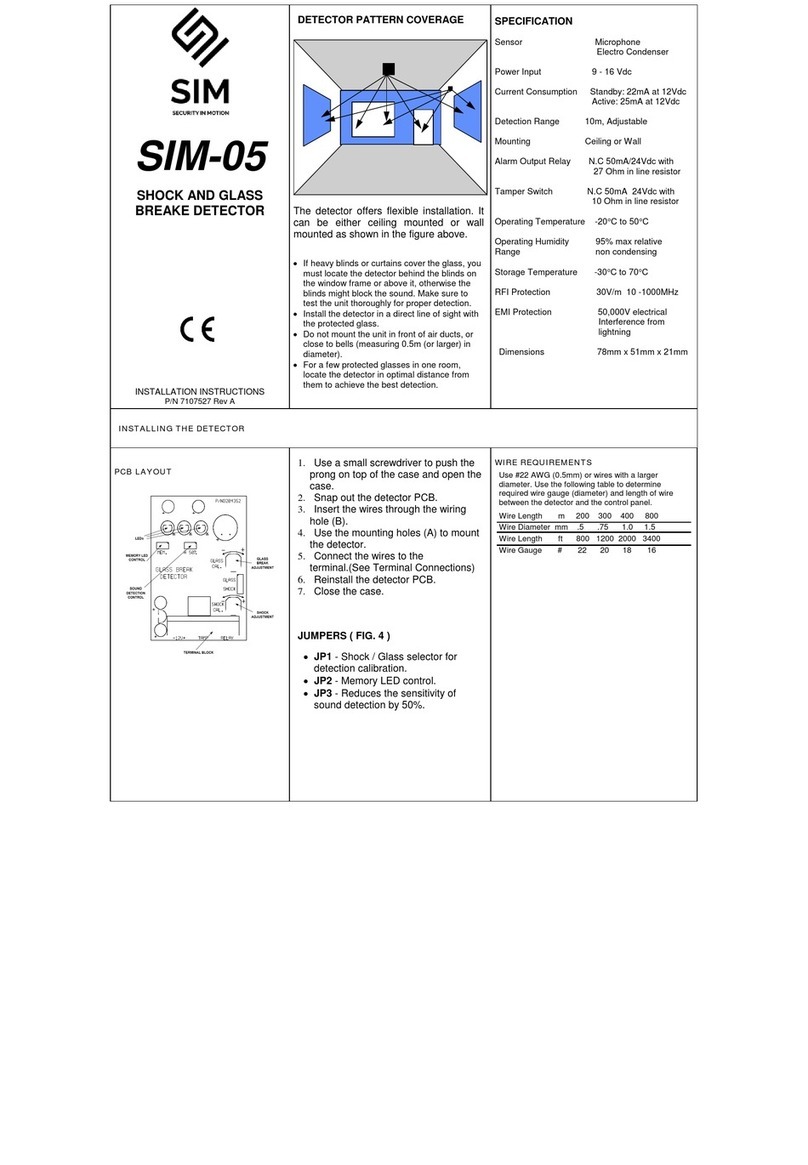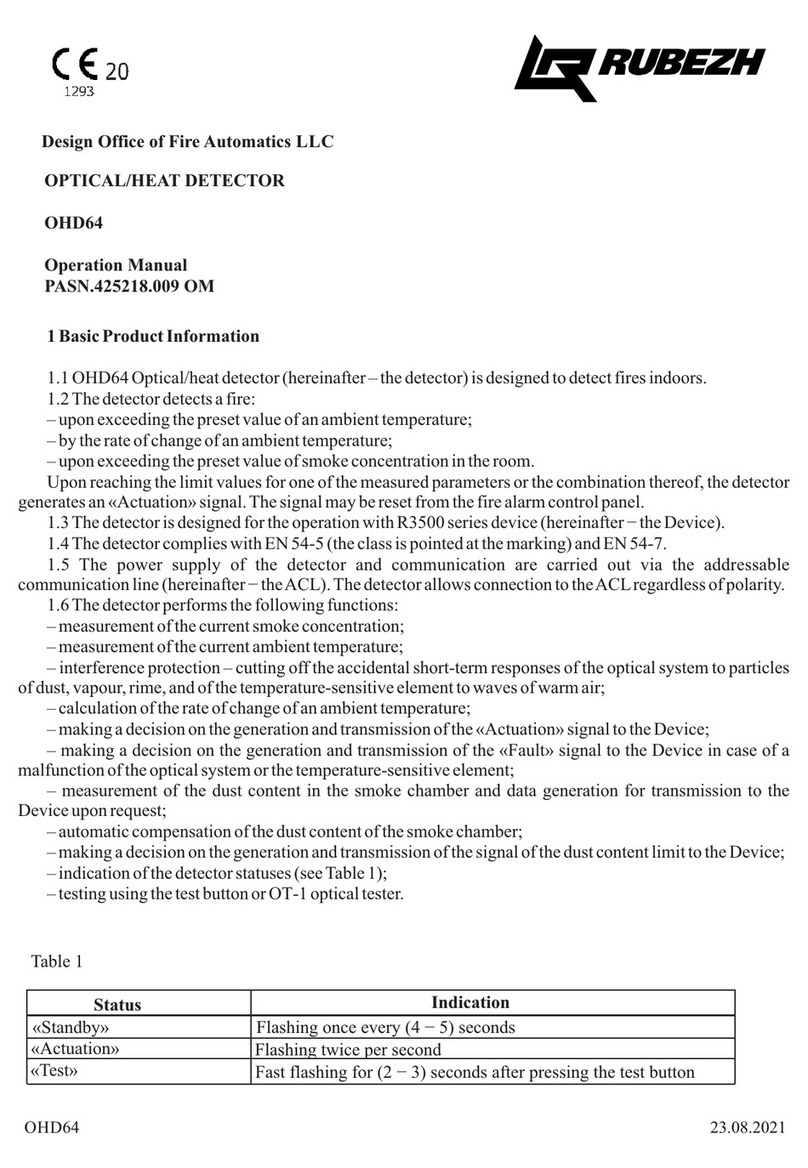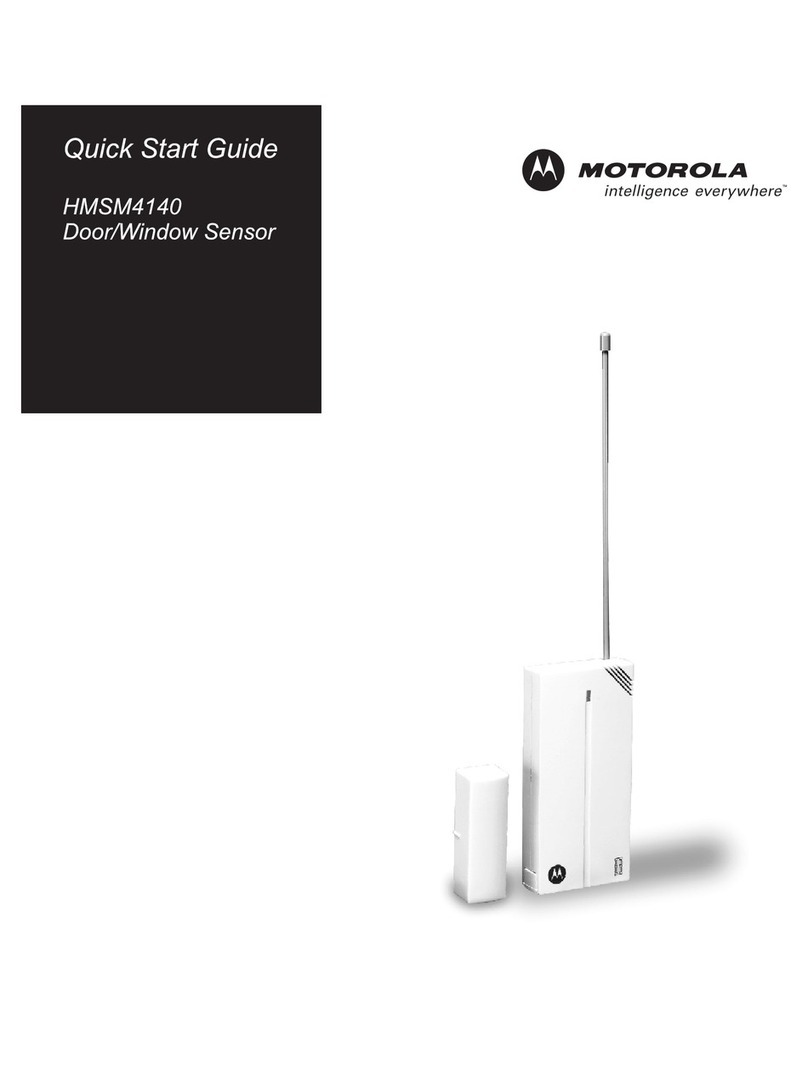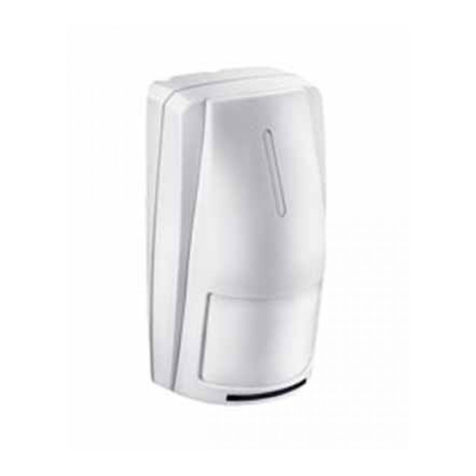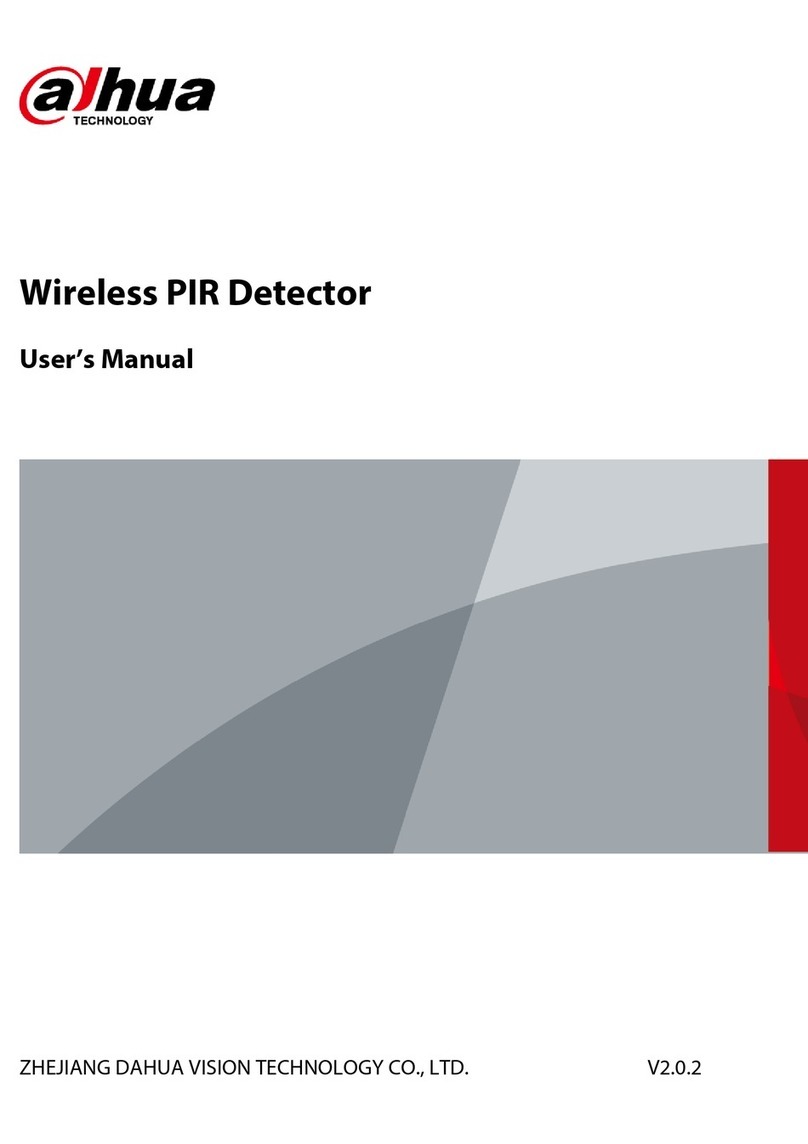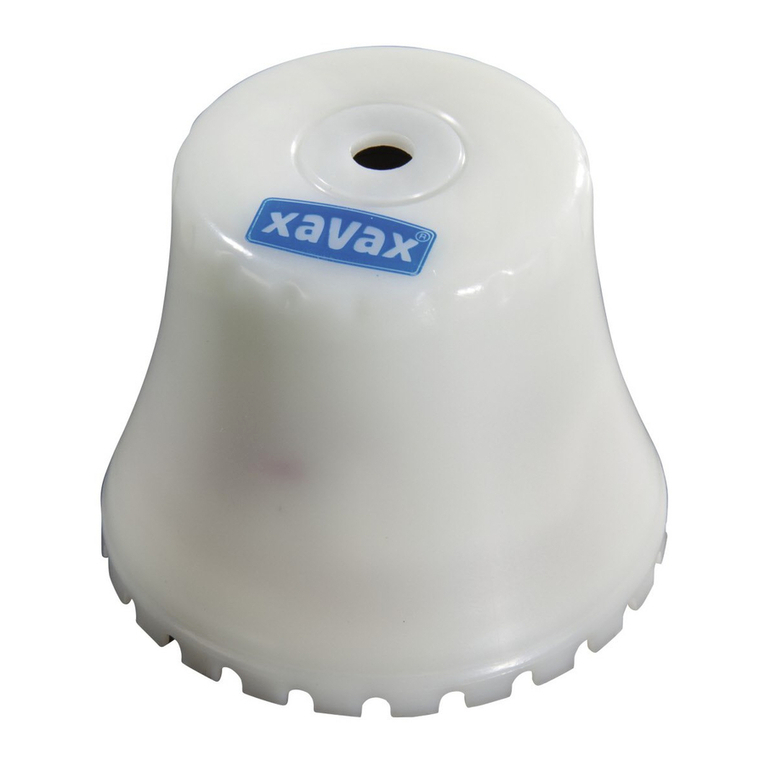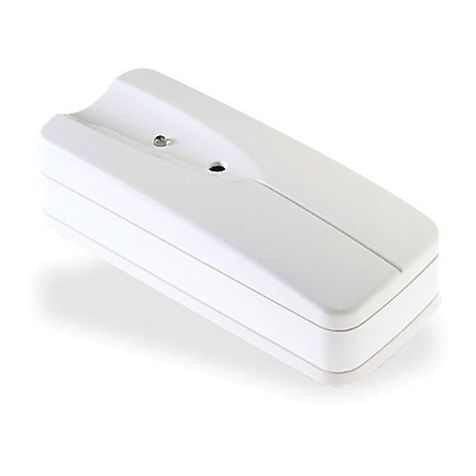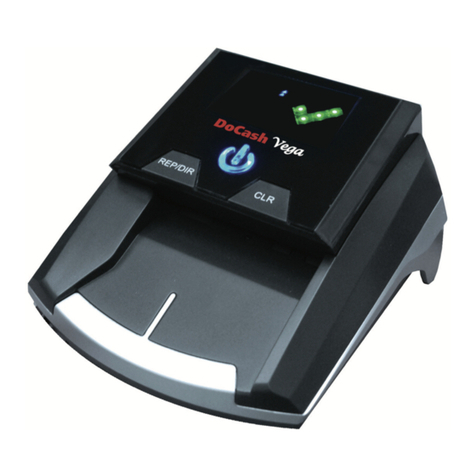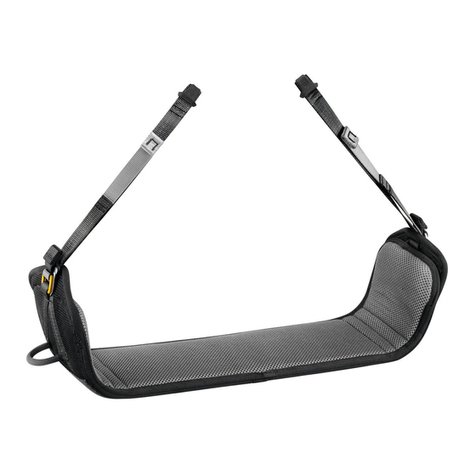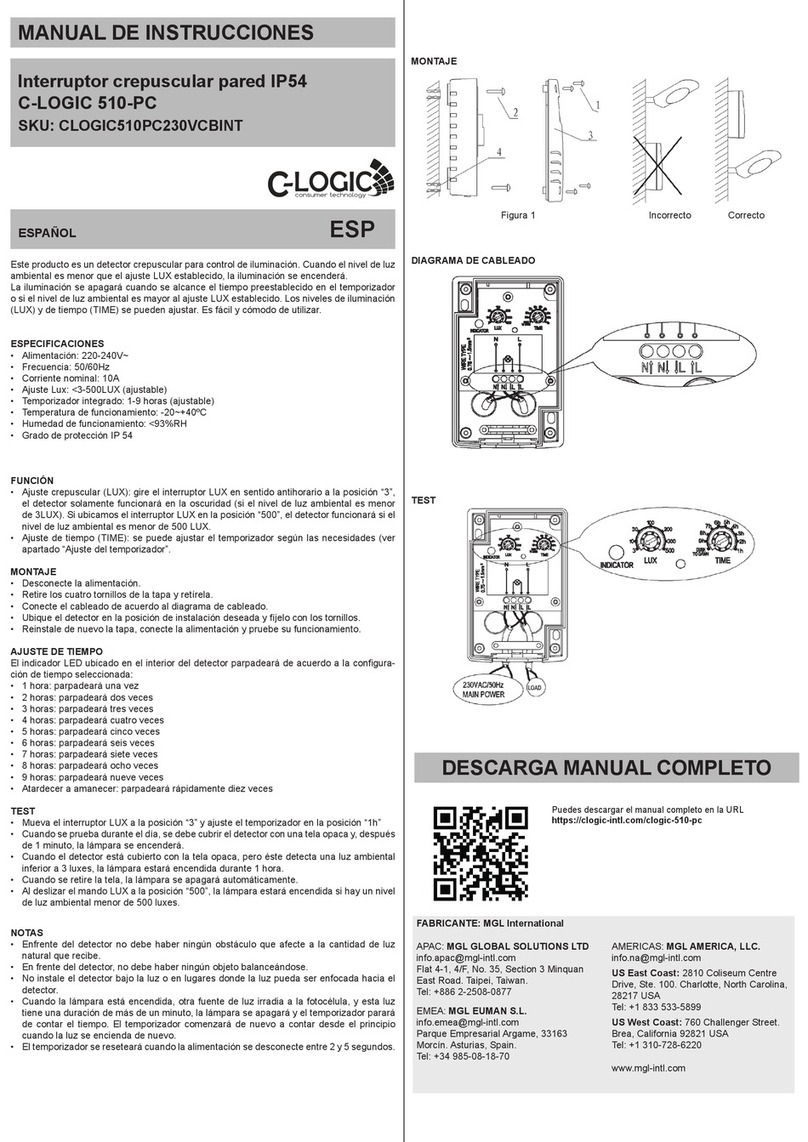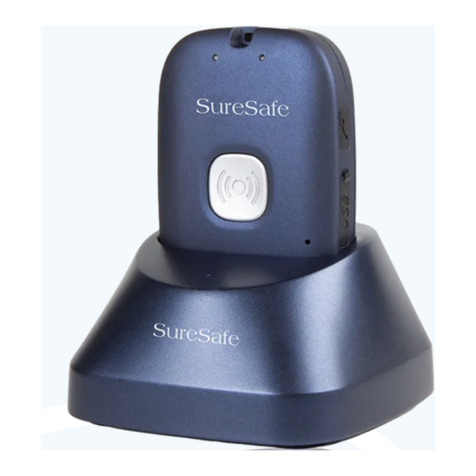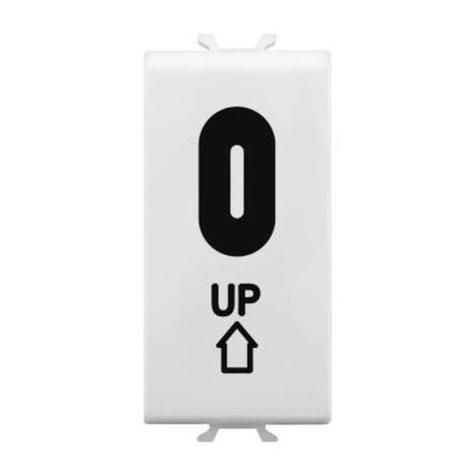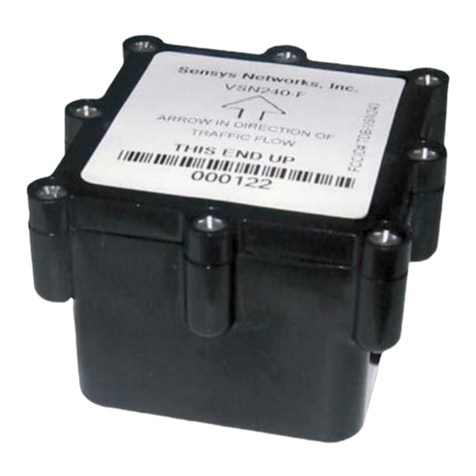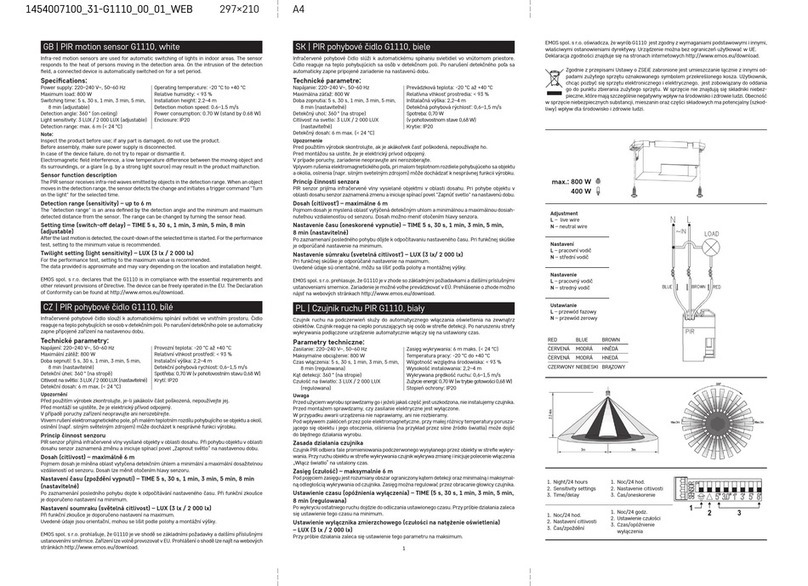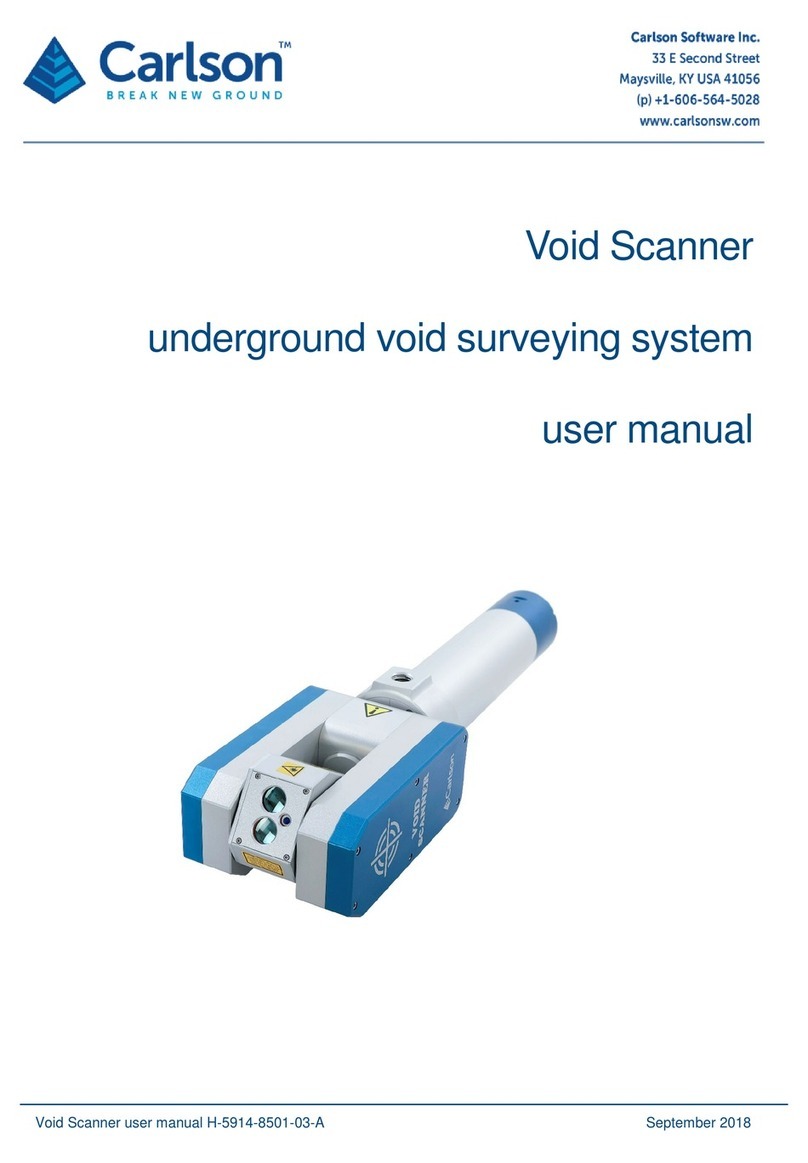SIM SIM-120 User manual

1
INSTALLATION MANUAL
P/N 7106901 Rev. A
SIM-120
OUTDOOR PIR + MW DETECTOR

2
Table Of Content
1General...................................................................................................................................... 3
2Features..................................................................................................................................... 3
3Assembly description:................................................................................................................ 3
4Detection Pattern: ...................................................................................................................... 4
5Selecting mounting location....................................................................................................... 5
6Detector Installation ................................................................................................................... 6
7Terminal Block Connections ...................................................................................................... 8
7.1 Wire Size Requirements .................................................................................................. 8
8Settings & Adjustments.............................................................................................................. 9
8.1 Detection beam direction ................................................................................................ 9
8.2 Detection range setting ................................................................................................... 9
8.3 Sensitivity, Range and Pet immune Adjustment......................................................... 10
8.4 Indications setting.......................................................................................................... 11
9Operation................................................................................................................................. 12
10 Test Procedure ........................................................................................................................ 12
11 Specifications........................................................................................................................... 13

3
1 General
The SIM-120 is a PIR and Microwave detector for outdoor and harsh environment applications.
The detection sensitivity and range is controlled by digital rotary switch allowing 16 calibration
levels, so that the effective pattern will be set for every installation environment and protection
site.
2 Features
MW detection based on Doppler concept.
N.O. & N. C. Relays switched at the same time.
Height installation calibrations free, from 0.8m to 1.5m
Selectable pet immunity between 20kg and 35kg.
16 levels of PIR sensitivity adjustment including 3 MW sensitivity groups.
Temperature compensation.
Front and back tamper protection.
Sound indication for walk test and intruder detection.
Unique waterproof and seal plastic design.
Detection Range: Up to 15m
Detect human intruders walking or running.
3Assembly description:
The SIM-120 includes big indication led prism that can be easily observed from long distance.
Having a back metal bracket, the SIM-120 can be easily mounted to walls and poles using
mounting screws or metal bands (supplied).
The SIM-120 is combined of three detection elements:
Upper PIR element
Lower PIR element
Microwave element
The upper PIR element has an adjustable detection height
while the other two are fixed.

4
Internal elements:
4 Detection Pattern:
The SIM-120 has a 90° top view PIR and MW detection pattern with over 15m detection distance
(when installed at 1.2m above the ground surface).
The SIM-120 has an internal rotating housing (which includes the 2 PIR elements and the MW)
that can be adjusted horizontally, so its 90° coverage may vary between 0° and 180°.
Upper PIR element
Lower PIR element
Microwave element
LED
Terminal Connection Blocks
LED and Buzzer dipswitches
Sensitivity setting
Direction Angle Indicator
Range setting handle
Range Indication
Tamper switch
Bracket locking screw
Detection area
Upper PIR element detection pattern
Adjustable between 3m to 15m
Lower PIR element detection pattern
Fixed to 15m range
Microwave detection pattern
Detection
No Detection
No pet detection in
all protected area
15m
15m

5
5 Selecting mounting location
The installation of the SIM-120 requires straight and solid base for the detector and setting of
front panel against the center of protected area.
The protected area must be free from obstacles like walls, fences, trees, ditches and other
microwave detectors, as well as systems of anti-intrusion surveillance.
The bracket provides SIM-120 installation on a wall or pole. The wall or pole should be leveled.
Choose a location most likely to intercept an intruder according to detection pattern on page 6.
Avoid the following Installation Locations:
Facing direct sunlight.
Facing areas subject to rapid temperature changes.
Wall angle of more than 10º from perpendicular line.
Mounting at more than 10º Deviation from horizontal line.
Facing metal doors.
Do not install near direct source of heat or air gust.
Clear all physical obstacles from the detection area
(e.g. Plants, laundries, etc.)
Clear all light reflecting surfaces from the detection area,
as well as water puddles.
Avoid installation on the following types of ground:
Thick vegetation, Grass (un-mown), Water, Sand and Metal.
NOTE:
Recommended installation height is 4 ft (1.2m).
The SIM-120 performs best when provided with a constant and stable environment.
In order to ensure suitable operation of the SIM-120 type of ground should be one of the
following: Asphalt concrete, Cement, Soil, Clay, Gravel or Grass (mown).

6
6 Detector Installation
1. Install the detector in such manner that the intruder
is most likely to cross the detection area from side to
side.
2. The detector is to be installed at height of 2.6 ft
(0.8m) to 4.9 ft (1.5m)
3. Make sure to attach the metal bracket to a leveled
straight and firm wall, leaving 6 inches (15cm) from
the top and 6 inches (15cm) from both sides, for easy
installation and maintenance.
4. Rotating the detection beam may be required for
guarding a side window opening while the detector is
installed facing another direction.
5. Open the detector unwinding the bottom screw.
6. Release the rear metal bracket by unwinding
internal bottom screw.
7. Release the detector body from the metal bracket
by polling front and up.
8. Attach the rear bracket to the wall or a pole using
mounting screws or metal bands.

7
9. Break the relevant rear knockouts on plastic base
rear side for your installation and slide the wires from
the outside via the paths and knockout to the internal
side of the detector.
10. Attach the sealing “U” shaped Sponge Pad to the
wire opening from the rear side after the wires
connection and prior to final product affixing to the
mounted bracket.
11. Place the detector on the mounting bracket from top
side down and then lock the screw at the bottom.
12. Connect the wires to the terminal blocks
according to the following chapter.

8
7 Terminal Block Connections
Terminal 1 - Marked “-” (GND) - Connect to the ground of the CP.
Terminal 2 - Marked “+” (+12V) - Connect to a positive Voltage of 9.6 -16Vdc source
(usually from the alarm CP)
Terminals 3 & 4 - Marked “TAMP” -If a Tamper function is required connect these
Terminals to a 24-hour normally closed protective zone in the CP.
If the top cover of the detector is opened or the detector is detached from installation wall, an
immediate alarm signal will be sent to the CP.
Terminal 5 - Marked “EOL” - End of line –optional terminal for end of line resistors
connections.
Terminals 6, 7 & 8 - Marked “NC / C / NO” -These are the output relay contacts of the
detector. Connect to a normally closed or normally opened zone in the control unit. When an
intruder is detected, alarm relays (N.C. and N.O.) will switch for 1.8 sec.
7.1 Wire Size Requirements
Use #22 AWG or larger wires. Use the following table to determine required wire gauge and
length.
Wire Length [m]
250
350
600
1000
Wire Length [ft.]
800
1200
2000
3400
Wire Gauge [#]
22
20
18
16

9
8 Settings & Adjustments
8.1 Detection beam direction
The SIM-120 detection beam direction may vary between 0º and 180º.
In order to change the detection beam direction rotate the internal detection element
housing to the desired direction.
8.2 Detection range setting
The SIM-120 detection range may vary between 10 ft (3m) and 49 ft (15m), while installed
on 4 ft (1.2m) height above the ground surface.
Changing the detection range is achieved by sliding the upper detection element up or
down.
Slide the detection element down for long range or up for short range detection.
Long Range Short Range
15m
15m

10
8.3 Sensitivity, Range and Pet immune Adjustment
The calibration of range and sensitivity is performed by single digital 16 position rotary
switch.
There are 3 groups of switch setting according to detection range.
Each group is divided to several levels of sensitivity according to installation environment.
The sensitivity is determined by a rotating switch (16 positions). Changing the sensitivity
affects immunity to environmental noises, also affects the detection distance and pet
immunity level.
The rotating switch is marked with digits from “0” to “9” and following letters from “A” to “F”.
Position “0” is maximum sensitivity and “F” is minimum sensitivity.
Note: Adjust sensitivity according to environmental conditions!
Group A - positions 0 –7 –set sensitivity for 15m detection range with immunity to pets weight
up to 15kg –very sensitive –1 pulse.
Group B - positions 8 –A –set sensitivity for 10m detection range with immunity to pets weight
up to 20kg –less sensitive –2 pulses.
Group C - positions B –F –set sensitivity for 5m detection range with immunity to pets weight
up to 35kg –less sensitive –2 pulses.
0
8
4
C
3
2
1
F
E
D
B
A
9
7
6
5
Low Risk
Risk
High Risk
Very High Risk
Noisy Area
Extremely Noisy Area
Low Risk
Risk
High Risk
Very High Risk
Noisy Area
Low Risk
Risk
High Risk
Very High Risk
Noisy Area
15m
Pet Immune
up to 15kg
1 Pulse
10m
Pet Immune
up to 20kg
2 Pulses
5m Pet
Immune
up to 35kg
2 Pulses
Each group is divided to 5 or 6 sub-positions that help to define the environmental
condition inside the detection range:
Low risk: very stable environment without interference like parking garage, under roof
parking space, playground, football court, service road, etc.
Risk: Stable environment with some trees, bushes, flowerpots, planters.

11
High risk: Unstable environment with different types of vegetation and grass and
puddles.
Very high risk: Unstable environment with winds and small pets, rats, mice, birds.
Noisy area: Unstable environment with vegetation and water sources like swimming
pool, lake, canal, weed as well as small pets like cats and rabbits.
Extremely Noisy area: Very unstable environment subjected to wind, snow, rain, with
vegetation, water and large pets like dogs.
For example:
If detector is used for 13m range in open space with sunlight and pets, set switch to position 9.
8.4 Indications setting
The SIM-120 has two types of indications:
1. LED
2. Buzzer
The installer may determine both indications’ operation during detection (ON or OFF) by using
switch number “1” for the buzzer and switch number “2” for the LED.
(Setting the buzzer ON gives the installer the ability to hear the beep on each detection for 1.8
seconds during the adjustments and a walk test. After the process it is recommended to switch
the buzzer OFF)
LED OFF
ON
OFF
Buzzer ON
ON
OFF
Factory default setting
Factory default setting

12
Place the top cover to the base and close it using the bottom screw.
9 Operation
Note! Connect the SIM-120 to a positive Voltage output of 9.6 -16VDC source.
Use only a listed power limited source.
The detector shall be provided with minimum of 4 hours of standby power from either a
listed compatible control unit or power supply.
The detector is automatically operated once connected to power.
The LED starts flashing for 30 seconds during the setup period and after that it will turn off.
At this time the detector is ready for operation.
10 Test Procedure
Walk Test
Allow 2 minutes of warm up time.
Make sure that the protected area is cleared of all people.
Start walking across the detection zone.
Listen to ALARM sound whenever motion is detected (the red LED also turns ON whenever
motion is detected).
Allow 5 sec. between each test for the detector to stabilize.
Upon installation, the unit should be thoroughly tested to verify proper operation.
Walk across the entire area where coverage is desired. Should the coverage be incomplete,
readjust coverage range or relocate the detector.
Once coverage is as desired, the alarm buzzer should be disabled and the LED may be disabled.

13
11 Specifications
Detection Method
Double PIR AND MW
Microwave Frequency
24.125 GHz
Power Input
9.6 to 16Vdc
Current Draw
Active: 24mA (±5%)
Standby: 21mA (±5%)
Temp Compensation
Yes, Dual slop temperature compensation
Alarm Period
2 sec (±0.5sec)
Alarm Outputs
Form C (NC, NO, Common)
28Vdc 0.1 A with 10 Ohm
Tamper Switch(s)
Two Switches
N.C 28Vdc 0.1A with 10 Ohm Series protection resistors
Opens when cover is removed from unit’s base
Warm up Period
120sec (± 5sec)
LED Indicator
LED is ON during ALARM
RF Immunity
10 V/m plus 80% AM from 80 MHz to 2GHz
Electro Static Immunity
6kV contact, 8kV air
Transient Immunity
1kV
Operation Temp
-35ºC ~ +55ºC
Dimensions
200mm x 86mm x 80mm
Weight
500gr.
Protection Degree
IP 65
Table of contents
Other SIM Security Sensor manuals


